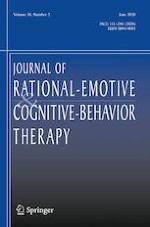20-04-2020
The Factor Structure of the Attitudes and Beliefs Scale 2: Implications for Rational Emotive Behavior Therapy
Gepubliceerd in: Journal of Rational-Emotive & Cognitive-Behavior Therapy | Uitgave 2/2020
Log in om toegang te krijgenAbstract
This study tested the factor structure of the Attitudes and Beliefs Scale-2, a measure of Ellis’ irrational and rational beliefs. The scale includes items that assess both irrationality and rationality. Within this framework, items reflect one of four irrational cognitive processes and their rational alternatives, including demandingness versus preferences, frustration intolerance versus tolerance, awfulizing versus realistic negative evaluations, and self-condemnation versus self-acceptance, and one of three content domains including affiliation, achievement, and comfort. The sample of 1500 consisted of college students, psychotherapy outpatients, and patients from a residential substance abuse program. We used the lavaan program with Diagonally Weighted Least Squares estimation procedures to test 11 different models. An 8-factor bifactor model had an excellent fit and appeared better than the other models using. This model had items load on one of the four irrational cognitive process factors of demandingness, awfulizing, frustration intolerance, or self-condemnation, or one of the rational cognitive process factors of non-demanding preferences, realistic negative evaluations, frustration tolerance, or self-acceptance. The second or bifactor solution had all items load on to one general factor. This model has eight factors that are designed to assess factors for the cognitive processes split into the irrational and rationality dimensions, and these results support the factor structure of the test and the theoretical structure of irrational and rational beliefs currently adopted in REBT. The implications for REBT practice were discussed as well as the future of assessment research in REBT.
